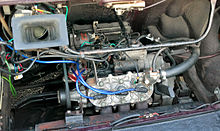Three cylinders
C engine — 2-stroke
- C10 —785 cc (47.9 cu in)70 mm × 68 mm (2.76 in × 2.68 in)
- 1965.12–1969.10 Suzuki Fronte 800
- C20 —1,100 cc (67.1 cu in)–80 PS (59 kW) prototype engine for intended Suzuki Fronte 1100
LC engine

1967–1977 – Suzuki LC engine – 0.36–0.48 L
FB engine
1975–1987 – FB Series – 0.54 L
Rather than being a newly developed engine, the T5 series is essentially an FB/L50 2-cylinder with a third cylinder added, its origins thus dating back to 1961.
F engine
1980–2022 – F engine (three-cylinder) – 0.5–0.8 L
G engine
1984–2006 – G engine (three-cylinder) 1.0 L
K engine
1994–present – K engine (three-cylinder) – 0.7–1.0 L
R engine
2011–present – 0.7 L
Z engine
2023–present – 1.2 L
Z12E
Developed as the successor of K12 engine, introduced first in November 2023. It is also available with mild hybrid configuration, combined with ISG unit.
- Displacement: 1,197 cc (1.2 L)
- Bore and stroke: 74 mm x 92.8 mm
- Valvetrain: DOHC, 12-valve, Dual VVT
- Compression ratio: 13.0–13.9
- Maximum power:
- 82–83 PS (60–61 kW; 81–82 hp) at 5700 rpm
- Maximum torque:108-112N⋅m(11–11.4 kg⋅m; 80–83 lb⋅ft) at 4500 rpm
Applications:
- 2023–present Suzuki Swift
- 2024–present Suzuki Dzire
- 2025–present Suzuki Solio